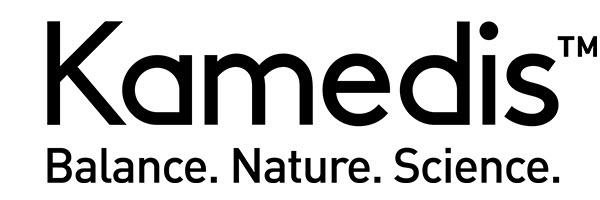Biological activities
Stimulation of Innate Immunity
In vitro studies using primary keratinocytes demonstrated that IL-4 and IL-13 cytokines, overexpressed in AD, inhibit the expression of b-defensins. Thus elevation of b-defensins or/and inhibition of IL-4 and IL-13 cytokines.
Human basophilic culture model was used to demonstrate the ability of the extracts to inhibit IL-13 release in dose response manner. An example is shown in Figure 4.
Figure 4. Inhibition of IL-13 release from stimulated basophils, by Ailanthus altissima extract (Mean±SE)

Stimulation of human b-defensin-3 (hBD-3) in human keratinocytes ability of the herbal extracts to directly. The stimulation effect of the extract was 11-fold higher than that of the control. An example is shown in Figure 5.
Figure 5. Stimulation effect of 0.33% Ailanthus altissima extract on human hBD-3 measured by Real-Time PCR. The relative expression of extracts was calculated, adjusting for the real-time PCR of glyceraldehyde 3-phosphate dehydrogenase (GAPDH) expression (GAPDH normalization).

Allergens may penetrate the skin and produce even greater Th2 cell response contributing to symptom exacerbation.
Histamine is a molecule involved in allergic pathologic processes such as pruritus, inflammation, and vascular leak. Mast cells and basophils immune cells store histamine in granules and secrete histamine quickly upon stimulation.
Strong effect of herbal extract on histamine release from stimulated mast cells was observed shown in Figure 6.
Figure 6. Inhibition of histamine release by herbal extract in stimulated mast cells (Mean±SE)

Anti-Inflammatory Activity - Reduction of PGE2 release
Kamedis herbal extracts significantly reduce PGE2 secretion from human keratinocytes. An example is shown in Figure 7.
Figure 7. Inhibition of PGE2 secretion by herbal extract in human keratinocytes.

Anti-Inflammatory Activity- Reduction of TNF- release
The release of TNF- from stimulated human keratinocytes was significantly inhibited by low concentrations of herbal extracts shown below in Figure 8.
Figure 8. Inhibition of TNF-secretion from keratinocytes by herbal extract in vitro (Mean±SE)

This prominent anti- TNF- effect was observed in most herbal extracts incorporated in our products.
Anti-Inflammatory Activity – Reduction of IL-6 release
The secretion of IL-6 from stimulated human keratinocytes was reduced when the cells were exposed to herbal extracts. An example is shown in Figure 9.
Figure 9. Inhibition of IL-6 secretion by herbal extract in stimulated keratinocytes. (Mean±SE)

Anti-Microbial Activity - P. acnes
Two assays were utilized to demonstrate ability of herbal extracts to inhibit P. acnes growth. An example is shown below.
For agar diffusion assay the herbal extract was applied onto the filter-paper disc which was placed on soft agar plates seeded with P. acne. The diameter of inhibition zone (clear halo around the disc) was measured to be 55 mm (Figure 10).
Microplate dilution assay was used to evaluate anti-microbial activity against P. acnes. This is a quantitative analysis aimed to determine the inhibitory concentration of each extract against each pathogen in its growth medium. The results are expressed as MIC (minimal inhibitory concentration) - minimal concentration in which no growth was observed.
The lowest inhibitory concentration affecting P. acnes growth we found among some of our herbal extracts was 100 microG/mL.
Figure 10. Antibacterial activity of herbal extract against P. acnes as measured in agar diffusion assay

Anti-microbial activity - M. furfur
Microplate dilution assay was used to evaluate anti-microbial activity against M. furfur. This is a quantitative analysis aimed to determine the inhibitory concentration of each extract against each pathogen in its growth medium. The results are expressed as MIC (minimal inhibitory concentration) - minimal concentration in which no growth was observed.
The lowest inhibitory concentration affecting Malassezia growth we found among some of our herbal extracts is 1.5 mG/mL.
Kamedis herbal extracts demonstrate strong anti-oxidative activity using scavenging assay, which is based on the measurement of the scavenging effect of antioxidants on the stable radical 2,2-diphenyl-1-picrylhydrazyl (DPPH) shown in Figure 11.
Figure 11. The herbal extract attenuated oxidative stress in induced human keratinocytes. (Mean±SE)

Anti-Proliferative Activity
Selective effect of herbal extracts on proliferation of inflamed skin cells was found. An example is shown in Figure 12.
Figure 12. Effect of herbal extract on viability of human keratinocytes (MTT assay).

